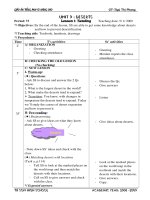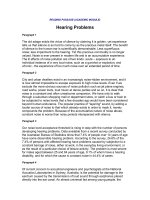ipv6 advanced protocols implementation
Bạn đang xem bản rút gọn của tài liệu. Xem và tải ngay bản đầy đủ của tài liệu tại đây (9.41 MB, 1,009 trang )
IPv6 Advanced Protocols
Implementation
The Morgan Kaufmann Series in Networking
Series Editor: David Clark, M.I.T.
IPv6 Advanced Protocols Implementation
Qing Li, Tatuya Jinmei, and Keiichi Shima
Computer Networks: A Systems Approach, 4e
Larry L. Peterson and Bruce S. Davie
Network Routing: Algorithms, Protocols, and
Architectures
Deepankar Medhi and Karthikeyan Ramaswami
Deploying IP and MPLS QoS for Multiservice Networks:
Theory and Practice
John Evans and Clarence Filsfils
Traffic Engineering and QoS Optimization of Integrated
Voice and Data Networks
Gerald R. Ash
IPv6 Core Protocols Implementation
Qing Li, Tatuya Jinmei, and Keiichi Shima
Smart Phone and Next-Generation Mobile
Computing
Pei Zheng and Lionel Ni
GMPLS: Architecture and Applications
Adrian Farrel and Igor Bryskin
Network Security: A Practical Approach
Jan L. Harrington
Content Networking: Architecture, Protocols, and
Practice
Markus Hofmann and Leland R. Beaumont
Network Algorithmics: An Interdisciplinary Approach to
Designing Fast Networked Devices
George Varghese
Network Recovery: Protection and Restoration of
Optical, SONET-SDH, IP, and MPLS
Jean Philippe Vasseur, Mario Pickavet,
and Piet Demeester
Routing, Flow, and Capacity Design in Communication
and Computer Networks
Michal Pi´oro and Deepankar Medhi
Wir eless Sensor Networks: An Information Processing
Approach
Feng Zhao and Leonidas Guibas
Communication Networking: An Analytical Approach
Anurag Kumar, D. Manjunath, and Joy Kuri
The Internet and Its Protocols: A Comparative Approach
Adrian Farrel
Modern Cable Television Technology: Video, Voice, and
Data Communications, 2e
Walter Ciciora, James Farmer, David Large,
and Michael Adams
Bluetooth Application Programming with the Java APIs
C. Bala Kumar, Paul J. Kline,
and Timothy J. Thompson
Policy-Based Network Management: Solutions for the
Next Generation
John Strassner
Network Architecture, Analysis, and Design, 2e
James D. McCabe
MPLS Network Management: MIBs, Tools, and
Techniques
Thomas D. Nadeau
Developing IP-Based Services: Solutions for Service
Providers and Vendors
Monique Morrow and Kateel Vijayananda
Telecommunications Law in the Internet Age
Sharon K. Black
Optical Networks: A Practical Perspective, 2e
Rajiv Ramaswami and Kumar N. Sivarajan
Internet QoS: Architectures and Mechanisms
Zheng Wang
TCP/IP Sockets in Java: Practical Guide for
Programmers
Michael J. Donahoo and Kenneth L. Calvert
TCP/IP Sockets in C: Practical Guide for Programmers
Kenneth L. Calvert and Michael J. Donahoo
Multicast Communication: Protocols, Programming,
and Applications
Ralph Wittmann and Martina Zitterbart
MPLS: Technology and Applications
Bruce Davie and Yakov Rekhter
High-Performance Communication Networks, 2e
Jean Walrand and Pravin Varaiya
Internetworking Multimedia
Jon Crowcroft, Mark Handley, and Ian Wakeman
Understanding Networked Applications: A First Course
David G. Messerschmitt
Integrated Management of Networked Systems:
Concepts, Architectures, and Their Operational
Application
Heinz-Gerd Hegering, Sebastian Abeck,
and Bernhard Neumair
Virtual Private Networks: Making the Right Connection
Dennis Fowler
Networked Applications: A Guide to the New Computing
Infrastructur e
David G. Messerschmitt
Wide Area Network Design: Concepts and Tools for
Optimization
Robert S. Cahn
For further information on these books and for a list
of forthcoming titles, please visit our Web site at
.
IPv6 Advanced Protocols
Implementation
Qing Li
Blue Coat Systems, Inc.
Tatuya Jinmei
Toshiba Corporation
Keiichi Shima
Internet Initiative Japan, Inc.
AMSTERDAM
•
BOSTON
•
HEIDELBERG
•
LONDON
NEW YORK
•
OXFORD
•
PARIS
•
SAN DIEGO
SAN FRANCISCO
•
SINGAPORE
•
SYDNEY
•
TOKYO
Morgan Kaufmann Publishers is an imprint of Elsevier
Senior Acquisitions Editor Rick Adams
Publishing Services Manager George Morrison
Senior Production Editor Dawnmarie Simpson
Acquisitions Editor Rachel Roumeliotis
Production Assistant Lianne Hong
Cover Design Eric DeCicco
Cover Image Side-by-Side Design
Cover Illustration Side-by-Side Design
Composition diacriTech
Technical Illustration diacriTech
Copyeditor JC Publishing
Proofreader Janet Cocker
Indexer Joan Green
Interior printer The Maple-Vail Book Manufacturing Group
Cover printer Phoenix Color Corporation
Morgan Kaufmann Publishers is an imprint of Elsevier.
500 Sansome Street, Suite 400, San Francisco, CA 94111
This book is printed on acid-free paper.
c
2007 by Elsevier Inc. All rights reserved.
Designations used by companies to distinguish their products are often claimed as trademarks or registered trademarks.
In all instances in which Morgan Kaufmann Publishers is aware of a claim, the product names appear in initial capital or
all capital letters. Readers, however, should contact the appropriate companies for more complete information regarding
trademarks and registration.
No part of this publication may be reproduced, stored in a retrieval system, or transmitted in any form or by any means—
electronic, mechanical, photocopying, scanning, or otherwise—without prior written permission of the publisher.
Permissions may be sought directly from Elsevier’s Science & Technology Rights Department in Oxford, UK: phone:
(+44) 1865 843830, fax: (+44) 1865 853333, E-mail: You may also complete your request online
via the Elsevier homepage (), by selecting “Support & Contact” then “Copyright and Permission” and
then “Obtaining Permissions.”
Library of Congress Cataloging-in-Publication Data
Li, Qing, 1971-
IPv6 advanced protocols implementation/Qing Li, Tatuya Jinmei, Keiichi Shima.
p. cm.
Includes bibliographical references and index.
ISBN-13: 978-0-12-370479-5 (hardcover: alk. paper)
ISBN-10: 0-12-370479-0 (hardcover: alk. paper) 1. TCP/IP (Computer network protocol)
I. Jinmei, Tatuya, 1971- II. Shima, Keiichi, 1970- III. Title.
TK5105.585.L536 2007
004.6
2–dc22
2006038489
ISBN: 978-0-12-370479-5
For information on all Morgan Kaufmann publications,
visit our Web site at www.mkp.com or www.books.elsevier.com
Printed in the United States of America
07080910 54321
To Huaying, Jane and Adalia
in Him
—Qing Li
To my colleagues at KAME: working with you talented geeks was an exciting experience and
has even made this derivative project possible.
—Tatuya Jinmei
To all KAME developers, all people who developed the Internet, and all people who
will develop the future Internet.
—Keiichi Shima
This page intentionally left blank
Contents
Preface xix
About the Authors xxv
1 IPv6 Unicast Routing Protocols 1
1.1 Introduction 1
1.2 Overview of Routing Concepts 2
1.3 Overview of Vector-based Algorithms and Link-State
Algorithm 5
1.3.1 Distance-Vector Algorithm 5
1.3.2 Path-Vector Algorithm 7
1.3.3 Link-State Algorithm 7
1.4 Introduction to RIPng 10
1.4.1 RIPng Message Formats 11
1.4.2 RIPng Operation 14
1.4.3 Problems with RIPng 15
1.5 Introduction to BGP4+ 17
1.5.1 BGP4+ Operation 19
1.5.2 BGP4+ Messages 21
1.5.3 Path Attributes 27
1.5.4 IPv6 Extensions for BGP4+ 29
1.5.5 BGP4+ Route Selection Process 31
vii
viii Contents
1.6 Introduction to OSPFv3 33
1.6.1 Router Adjacency and LSDB Synchronization 33
1.6.2 Area Types and Router Classification 35
1.6.3 Link State Advertisement and LSA Types 35
1.6.4 LSA For mats 37
1.6.5 OSPF Tree Construction and Route Computation 46
1.7 Code Introduction 49
1.8 IPv6 Routing Table in the BSD Kernel 50
1.8.1 Scope Zone Representation in the Routing
Table 53
1.9 Routing API 55
1.9.1 Routing Sockets 55
1.9.2 Dumping Routing Table via sysctl() 62
1.10 Overview of route6d Daemon 65
1.11 Common Data Structures, Routines and Global Variables 65
1.11.1 Structures for RIPng Messages 65
1.11.2 route6d’s Routing Table 67
1.11.3 Structures for Local Interfaces 68
1.11.4 route6d Route Filter Entry 70
1.11.5 Subroutines and Global Variables 72
1.12 Interface Configuration 74
1.12.1 ifconfig() Function 74
1.12.2 ifconfig1() Function 77
1.13 RIPng Protocol Operation 81
1.13.1 sendrequest() Function 82
1.13.2 riprecv() Function 83
1.13.3 riprequest() Function 96
1.13.4 ripsend() Function 97
1.13.5 ripalarm() Function 104
1.14 Routing Operation Using route6d 105
1.14.1 A Leaf Network 105
1.14.2 A Simple Loop Network 108
1.14.3 A Hierarchical Network 111
2 IPv6 Multicasting 113
2.1 Introduction 113
2.2 IPv6 Multicast Address to Layer-2 Multicast Address
Mapping 114
Contents ix
2.3 Multicast Listener Discovery Protocol 114
2.3.1 MLD Protocol Message Format 115
2.3.2 Router Alert Option 116
2.3.3 Source Address Selection 116
2.3.4 Destination Address Selection 116
2.3.5 MLD Querier 116
2.3.6 Operational Variables 117
2.3.7 MLD Join Process 118
2.3.8 MLD Leave Process 119
2.4 Multicast Routing Fundamentals 120
2.4.1 Reverse Path Forwarding 120
2.4.2 Multicast Routing Models 121
2.4.3 Protocol Independent Multicast 125
2.4.4 IPv6 Specific Issues about PIM 128
2.4.5 IPv6 Multicast Future—MLDv2 and SSM 130
2.5 Code Introduction 131
2.6 MLD Implementation 133
2.6.1 Types and Structures 133
2.6.2 mld6_init() Function 136
2.6.3 Joining a Group: mld6_start_listening()
Function 137
2.6.4 Leaving a Group: mld6_stop_listening()
Function 139
2.6.5 Input Processing: mld6_input() Function 140
2.6.6 mld6_fasttimeo() Function 144
2.6.7 mld6_sendpkt() Function 146
2.6.8 mld_allocbuf() Function 149
2.7 IPv6 Multicast Interface: mif6{} Structure 150
2.8 IPv6 Multicast Routing API 152
2.8.1 ip6_mrouter_set() Function 152
2.8.2 ip6_mrouter_init() Function 155
2.8.3 ip6_mrouter_get() Function 156
2.8.4 set_pim6() Function 157
2.8.5 add_m6if() Function 157
2.8.6 del_m6if() Function 160
2.8.7 ip6_mrouter_done() Function 161
2.8.8 mrt6_ioctl() Function 164
2.8.9 get_mif6_cnt() Function 164
x Contents
2.9 IPv6 Multicast Forwarding Cache 165
2.9.1 add_m6fc() Function 166
2.9.2 del_m6fc() Function 171
2.9.3 expire_upcalls() Function 172
2.9.4 get_sg_cnt() Function 173
2.10 IPv6 Multicast Forwarding 174
2.10.1 ip6_mforward() Function 175
2.10.2 ip6_mdq() Function 183
2.10.3 phyint_send() Function 189
2.10.4 register_send() Function 192
2.10.5 socket_send() Function 194
2.10.6 pim6_input() Function 195
2.11 IPv6 Multicast Operation 202
2.11.1 ifmcstat Command 202
2.11.2 Enable IPv6 Multicast Routing 203
2.11.3 pim6dd and pim6sd Routing Daemons 203
2.11.4 pim6stat Output 203
2.11.5 netstat Command 206
3 DNS for IPv6 207
3.1 Introduction 207
3.2 Basics of DNS Definitions and Protocols 208
3.2.1 DNS, Domains, and Zones 208
3.2.2 Resource Records and Zone Files 210
3.2.3 DNS Transaction and Packet Format 212
3.2.4 Name Resolution and Caching 214
3.3 IPv6-Related Topics about DNS 217
3.3.1 AAAA Resource Record 217
3.3.2 DNS Reverse Tree for IPv6 217
3.3.3 IPv6 Transport for DNS 219
3.3.4 Packet Size Issue and EDNS0 219
3.3.5 Misbehaving DNS Servers against AAAA 222
3.3.6 Obsolete Standards 225
3.4 Implementation of IPv6 DNS Resolver 226
3.4.1 _dns_getaddrinfo() Function 229
3.4.2 getanswer() Function 235
3.4.3 res_queryN() Function 243
3.4.4 Resolver State Structure 245
Contents xi
3.4.5 res_init() Function 248
3.4.6 res_send() Function 250
3.4.7 IPv6 Reverse Lookup: _dns_ghbyaddr()
Function 260
3.5 IPv6 DNS Operation with BIND 264
3.5.1 Overview of BIND9 265
3.5.2 Getting BIND9 266
3.5.3 Building and Installing BIND9 266
3.5.4 Configuring BIND9 for IPv6 Operation 267
3.5.5 Implementation-Specific Notes 274
3.5.6 Complete Configuration Example 282
3.5.7 dig and host Utilities 286
4 DHCPv6 289
4.1 Introduction 289
4.2 Overview of the DHCPv6 Protocol 290
4.2.1 Cases for DHCPv6 290
4.2.2 Definitions about DHCPv6 293
4.2.3 DHCPv6 Message Exchanges 297
4.2.4 Summary of DHCPv6 Options 310
4.2.5 Interaction with Neighbor Discovery 319
4.2.6 Comparison to DHCPv4 319
4.3 Code Introduction 320
4.3.1 Common Data Structures and Routines 320
4.4 Client Implementation 326
4.4.1 Client-Specific Data Structures 328
4.4.2 client6_mainloop() Function 332
4.4.3 client6_timo() Function 333
4.4.4 client6_send() Function 338
4.4.5 client6_recv() Function 344
4.4.6 client6_recvadvert() Function 346
4.4.7 client6_recvreply() Function 352
4.4.8 Processing Identity Association 357
4.4.9 update_ia() Function 359
4.4.10 update_address() Function 365
4.4.11 reestablish_ia() Function 369
4.4.12 ia_timo() Function 374
4.4.13 Release Resources 379
xii Contents
4.5 Server Implementation 382
4.5.1 server6_mainloop() Function 386
4.5.2 server6_recv() Function 387
4.5.3 process_relayforw() Function 391
4.5.4 react_solicit() Function 396
4.5.5 react_request() Function 401
4.5.6 make_ia() Function 406
4.5.7 react_renew() Function 417
4.5.8 react_rebind() Function 419
4.5.9 binding_time() Function 426
4.5.10 react_release() Function 428
4.5.11 react_informreq() Function 432
4.5.12 server6_send() Function 434
4.6 Relay Agent Implementation 439
4.6.1 relay6_loop() Function 439
4.6.2 relay6_recv() Function 441
4.6.3 relay_to_server() Function 444
4.6.4 relay_to_client() Function 450
4.7 Implementation of DHCPv6 Authentication 454
4.7.1 Data Structures Related to DHCPv6 Authentication 454
4.7.2 set_auth() Function 455
4.7.3 process_auth() Function (Client Side) 458
4.7.4 process_auth() Function (Server Side) 462
4.8 DHCPv6 Operation 468
4.8.1 Building the DHCPv6 Implementation 468
4.8.2 Configuring a DUID 469
4.8.3 Configuring the DHCPv6 Server 469
4.8.4 Configuring the DHCPv6 Client 470
4.8.5 Configuring the DHCPv6 Relay Agent 474
4.8.6 Configuring DHCPv6 Authentication 475
4.8.7 Configuring Control Command Keys 476
4.8.8 Operation of DHCPv6 Services 476
5 Mobile IPv6 485
5.1 Introduction 485
5.2 Mobile IPv6 Overview 486
5.2.1 Types of Nodes 487
5.2.2 Basic Operation of Mobile IPv6 488
Contents xiii
5.3 Header Extension 491
5.3.1 Alignment Requirements 493
5.3.2 Home Address Option 493
5.3.3 Type 2 Routing Header 494
5.3.4 Mobility Header 495
5.3.5 Mobility Options 503
5.3.6 Neighbor Discovery Messages 506
5.3.7 ICMPv6 Messages 509
5.4 Procedure of Mobile IPv6 512
5.4.1 Protocol Constants and Variables 512
5.4.2 Home Registration 512
5.4.3 Bi-directional Tunneling 516
5.4.4 Intercepting Packets for a Mobile Node 518
5.4.5 Returning Home 519
5.5 Route Optimization 521
5.5.1 Return Routability 522
5.5.2 Sending Initial Messages 522
5.5.3 Responding to Initial Messages 523
5.5.4 Computing a Shared Secret 525
5.5.5 Verifying Message 526
5.5.6 Security Considerations 527
5.5.7 De-Register Binding for Correspondent Nodes 528
5.5.8 Backward Compatibility 528
5.6 Movement Detection 529
5.7 Dynamic Home Agent Address Discovery 530
5.8 Mobile Prefix Solicitation/Advertisement 533
5.9 Relationship with IPsec 534
5.10 Code Introduction 537
5.10.1 Statistics 537
5.11 Mobile IPv6 Related Structures 539
5.11.1 Files 539
5.11.2 Mobility Header Message—ip6_mh{} Structure 539
5.11.3 Binding Refresh Request Message—ip6_mh_binding_request{}
Structure 541
5.11.4 Home Test Init Message—ip6_mh_home_test_init{}
Structure 541
5.11.5 Care-of Test Init Message—ip6_mh_careof_test_init{}
Structure 542
5.11.6 Home Test Message—ip6_mh_home_test{}
Structure 543
xiv Contents
5.11.7 Care-of Test Message—ip6_mh_careof_test{}
Structure 543
5.11.8 Binding Update Message—ip6_mh_binding_update{}
Structure 544
5.11.9 Binding Acknowledgment Message—ip6_mh_binding_ack{}
Structure 545
5.11.10 Binding Error Message—ip6_mh_binding_error{}
Structure 546
5.11.11 Mobility Option Message Structures 548
5.11.12 Mobility Option Message—ip6_mh_opt{} Structure 548
5.11.13 Binding Refresh Advice Option—ip6_mh_opt_refresh_advice{}
Structure 549
5.11.14 Alternate Care-of Address Option—ip6_mh_opt_altcoa{}
Structure 549
5.11.15 Nonce Index Option—ip6_mh_opt_nonce_index{}
Structure 550
5.11.16 Authentication Data Option—ip6_mh_opt_auth_data{}
Structure 550
5.11.17 The Internal Mobility Option—mip6_mobility_options{}
Structure 551
5.11.18 Home Address Option—ip6_opt_home_address{}
Structure 551
5.11.19 Type 2 Routing Header—ip6_rthdr2{} Structure 552
5.11.20 The Modified Router Advertisement Message—nd_router_advert{}
Structure 552
5.11.21 The Modified Prefix Information Option—nd_opt_prefix_info{}
Structure 553
5.11.22 Advertisement Interval Option—nd_opt_adv_interval{}
Structure 554
5.11.23 Home Agent Information Option—nd_opt_homeagent_info{}
Structure 554
5.11.24 Dynamic Home Agent Address Discovery Request Message—
mip6_dhaad_req{} Structure 555
5.11.25 Dynamic Home Agent Address Discovery Reply Message—
mip6_dhaad_rep{} Structure 555
5.11.26 Mobile Prefix Solicitation Message—mip6_prefix_solicit{}
Structure 556
5.11.27 Mobile Prefix Advertisement Message—mip6_prefix_advert{}
Structure 556
5.11.28 Binding Cache Entry—mip6_bc{} Structure 557
5.11.29 Binding Update List Entry—mip6_bu{} Structure 559
Contents xv
5.11.30 Home Agent Entry—mip6_ha{} structure 561
5.11.31 Prefix Entry—mip6_prefix{} Structure 562
5.11.32 Home Virtual Interface—hif_softc{} Structure 563
5.12 Macro and Type Definitions 567
5.13 Global Variables 570
5.14 Utility Functions 570
5.14.1 Files 570
5.14.2 Creation of IPv6 Header 570
5.14.3 Checksum Computation 572
5.15 Common Mobility Header Processing 575
5.15.1 Files 575
5.15.2 Mobility Header Input 575
5.15.3 Generating Binding Error Messages 581
5.15.4 Rate Limitation of Binding Error Messages 582
5.15.5 Creation of Binding Error Message 583
5.15.6 Mobility Header Message Delivery to Raw Sockets 585
5.16 Home Agent and Correspondent Node 588
5.16.1 Files 589
5.16.2 Binding Update Message Input 589
5.16.3 Binding Cache Entry Management 598
5.16.4 Mobility Options Processing 606
5.16.5 Validation of Binding Update Message for Correspondent
Node 608
5.16.6 K
bm
and Authorization Data Computation 610
5.16.7 Managing Binding Cache Entry as Correspondent
Node 615
5.16.8 Sending Binding Refresh Request Message 618
5.16.9 Home Registration Processing 622
5.16.10 The DAD Procedure 628
5.16.11 Proxy Neighbor Discovery Control 634
5.16.12 Home De-Registration Procedure 639
5.16.13 Sending a Binding Acknowledgment Message 642
5.16.14 Nonce and Nodekey Management 649
5.16.15 Receiving a Home Address Option 653
5.16.16 Sending Packets to Mobile Nodes via Tunnel 660
5.16.17 Recovery of Temporarily Disabled Proxy Entry 664
5.16.18 Receiving ICMPv6 Error Messages 666
5.16.19 Home Agent List Management 670
5.16.20 Prefix List Management 684
xvi Contents
5.16.21 Sending a Mobile Prefix Advertisement Message 684
5.16.22 Constructing the Payload 687
5.17 Mobile Node 689
5.17.1 Files 689
5.17.2 Binding Update List Entry Management 689
5.17.3 Movement Detection 699
5.17.4 Configuring Home Addresses 711
5.17.5 Sending a Binding Update Message 721
5.17.6 Receiving a Binding Acknowledgment Message 737
5.17.7 Receiving a T ype 2 Routing Header 750
5.17.8 Receiving a Binding Refresh Request Message 754
5.17.9 Receiving a Binding Error Message 755
5.17.10 Source Address Selection 758
5.17.11 Home Agent List Management 763
5.17.12 Prefix Information Management 772
5.17.13 Receiving Prefix Information by Router Advertisement
Messages 784
5.17.14 Sending a Mobile Prefix Solicitation Message 793
5.17.15 Receiving a Mobile Prefix Advertisement Message 796
5.17.16 Sending a Dynamic Home Agent Address Discovery Request
Message 804
5.17.17 Receiving a Dynamic Home Agent Address Discovery Reply
Message 808
5.17.18 Receiving ICMPv6 Error Messages 813
5.17.19 State Machine 815
5.17.20 Primary State Machine 817
5.17.21 Secondary State Machine 837
5.17.22 Virtual Home Interface 844
5.17.23 Return Routability and Route Optimization 857
5.17.24 Route Optimized Communication 874
5.17.25 Tunnel Control 884
5.17.26 Receiving Packets from a Tunnel 887
5.17.27 I/O Control 889
5.18 Mobile IPv6 Operation 892
5.18.1 Rebuilding a Kernel with Mobile IPv6 Extension 892
5.18.2 Rebuilding User Space Programs 893
5.18.3 IPsec Signal Protection 894
5.18.4 Configuring Node 897
Contents xvii
5.18.5 Viewing Status Information 899
5.18.6 Viewing Statistics 899
5.19 Appendix 901
5.19.1 The Manual Page of mip6control 901
6 IPv6 and IP Security 903
6.1 Introduction 903
6.2 Authentication Header 904
6.3 Encapsulating Security Payload 906
6.4 Transport Mode and Tunnel Mode 908
6.5 Security Association Database 909
6.5.1 Security Policy Database 910
6.5.2 Security Association Database 911
6.5.3 SAD and SPD Example 912
6.6 IPsec Traffic Processing 913
6.7 SPD and SAD Management 914
6.7.1 Manual Keying and Automatic Keying 915
6.8 Manual Configuration 916
6.8.1 Configuration File Format 917
6.8.2 Examples of Manipulating SP Entries 922
6.8.3 Examples of Manipulating SA Entries 924
6.9 Internet Security Association and Key Management Protocol
(ISAKMP) Overview 925
6.9.1 ISAKMP Exchanges 927
6.9.2 Domain of Interpretation 929
6.9.3 Internet Key Exchange Protocol 930
6.10 Racoon Operation 931
6.10.1 Configuring Racoon 931
6.10.2 Configuration File Format 932
6.11 Scenarios 937
6.11.1 Creating a VPN between 3 Networks 938
6.11.2 Creating Star Topology VPN 942
6.11.3 Using Transport Mode IP Security 945
6.11.4 Connecting to the Server from Public Access Points 949
References 953
Index 961
This page intentionally left blank
Preface
This book is the second installment of our series detailing IPv6 and related protocols through
the KAME implementation. KAME is a widely deployed de facto reference implementation for
IPv6 and IP security protocols developed on multiple variants of the BSD operating systems.
The first installment of this series is titled IPv6 Core Protocols Implementation, which is
referred to as the Core Protocols book below, and it focuses on the fundamentals of IPv6 and
the essential protocols that are supported by most implementations. These essential protocols
operate in IPv6-capable devices, large or small. Our Core Protocols book also describes IPv6
implication on higher layer protocols, such as TCP and UDP, and covers IPv6 related application
programming interfaces.
This second book discusses those protocols that are found in more capable IPv6 devices,
are commonly deployed in more complex IPv6 network environments, or are not specific to
IPv6 but are extended to support IPv6. Specifically, this book engages the readers in more
advanced topics, such as routing, multicasting, DNS, mobility, and security.
The general structure and style of this book is the same as that of the Core Protocols book;
each chapter begins with a summary of the relevant specifications followed by line-by-line code
description and analysis of the actual implementation.
We hope to help the readers establish a solid and empirical understanding of IPv6 with our
book series. Our two books together cover a wide spectrum of the IPv6 technology and are
paralleled by none.
This book consists of the following chapters:
• Chapter 1 (“IPv6 Unicast Routing Protocols”) discusses general routing concepts and the
fundamentals of various types of unicast routing protocols. This chapter details RIPng,
a simple routing protocol for IPv6, and summarizes IPv6-specific extensions defined for
the BGP4+ and OSPFv3 routing protocols. Comparisons are made among these proto-
cols in regards to protocol complexity, stability, and the operational issues and solutions
xix
xx Preface
offered by each. This chapter also provides the necessary background to implement IPv6
routing protocols on BSD variants through descriptions of the routing API for IPv6 and
code narrations of KAME’s RIPng implementation, the route6d daemon. This chapter
concludes with configuration examples of route6d for some typical scenarios.
• Chapter 2 (“IPv6 Multicasting”) discusses details about IPv6 multicasting, especially on
multicast routing mechanisms. It first provides the basics of a host-to-router protocol and
multicast routing protocols, specifically the Multicast Listener Discovery protocol version
1 (MLDv1) and Protocol Independent Multicast (PIM), focusing on IPv6 specific issues.
The latter part of this chapter describes the KAME kernel implementation of MLDv1 and
IPv6 multicast forwarding.
• Chapter 3 (“DNS for IPv6”) describes IPv6 extensions to the DNS (Domain Name System)
protocol specification and implementation. It begins with a general description of the
DNS protocol and its extensions that support IPv6. It then describes KAME’s DNS client
(called a resolver) implementation, and highlights the support for IPv6. This section also
gives a complete view of the getaddrinfo() library function, which was partially
described in the Core Protocols book. The latter half of this chapter shows how to
operate the BIND9 DNS server to support IPv6 with notes about common pitfalls and
issues specific to IPv6-related operations.
• Chapter 4 (“DHCPv6”) details DHCPv6 (Dynamic Host Configuration Protocol for IPv6)
both on the protocol specification and on KAME’s implementation. Although the basic
concept of the protocol is largely derived from DHCP for IPv4 (DHCPv4), DHCPv6 has
introduced various improvements in its design and the expected usage model differs
from that of DHCPv4; this chapter clarifies such major differences. The implementation
descriptions cover all protocol functionalities, that is, clients, servers, and relay agents,
and will provide an in-depth understanding of how the protocol works. This chapter also
provides how to operate DHCPv6 with the KAME implementation for some common
usage scenarios.
• Chapter 5 (“Mobile IPv6”) covers the IPv6 host mobility protocol known as Mobile IPv6.
The chapter begins with a basic description of Mobile IPv6, and then details protocol
specifications and data structures. The actual implementation is discussed in the middle
of the chapter. The KAME Mobile IPv6 implementation supports both home agent and
mobile node functions. The code description section will discuss all data structures and
functions in detail. This chapter also provides a brief instruction of Mobile IPv6 operation
with sample configuration files using the KAME Mobile IPv6 implementation at the end
of the chapter.
• Chapter 6 (“IPv6 and IP Security”) begins with an introduction of the IPsec protocols and
the concept of keying in the context of the Internet Key Exchange (IKE) protocol. The
remainder of this chapter then focuses on describing the popular racoon IKE daemon.
Its configuration and operation are thoroughly explained. This chapter concludes with
some practical examples of using racoon. Unlike other chapters, this chapter does not
provide any code description because the basic mechanism of IP Security and most of
its implementation are not specific to IPv6; including non-IPv6 specific code description
would change the main objective of this book.
Preface xxi
Intended Audience
In general, this book is intended for the same class of readers as was the Core Protocols book:
developers implementing IPv6 and related protocols, and students who are going to start a
project on these protocols, especially on top of or using the KAME/BSD implementation. Unlike
the Core Protocols book, however, this book discusses more advanced topics, such as protocols
that have been standardized relatively recently, so it can also be used as a reference to these
protocols per se; DHCPv6 and Mobile IPv6 are two specific examples of this.
As in the Core Protocols book, it is assumed that readers are fluent in the C programming
language. In addition, this book assumes knowledge of the basic notions of IPv6 and related
protocols described in the Core Protocols book, though other references within this book will
help those who cannot refer to the Core Protocols book to understand the contents. Chapters 2
and 5 also require general understanding of the BSD kernel implementation.
Unlike the Core Protocols book, each chapter of this book is quite independent; although
there are several cross references among the chapters, readers can generally start from any
chapter based on their interest.
Typographical Conventions
This book adopts the same typographical conventions as those for the Core Protocols book,
which is summarized as follows:
Variable, function, or structure names, structure members, and programming language key-
words are represented in a constant-width font when referred to in the code descriptions.
Function names are in a constant-width font followed by parentheses, as in
ip6_mforward(), and structure names are in a constant-width font followed by braces,
as in ip6_mh{} .
Program names are displayed in bold fonts, as in route6d. The command line input and
the output of a program are displayed in a constant-width font.
Accompanying CD-ROM
This book comes with two CD-ROMs. The first CD-ROM is an ISO image of FreeBSD4.8-
RELEASE, which is the base operating system covered in Chapters 1, 2, 3, and 6. It is a bootable
CD-ROM and includes installation files. The installation procedure is started by turning on the
computer with the CD-ROM loaded. The detailed installation procedure can be found in the
INSTALL.TXT file located in the root directory of the CD-ROM.
Similarly, the second CD-ROM is a bootable ISO image of FreeBSD4.9-RELEASE, which is
the base operating system covered in Chapter 5.
Note: FreeBSD 4.8 and 4.9 RELEASEs are known to have several security flaws and are no
longer supported by the FreeBSD project. Therefore, these systems should only be used
for reference on learning the KAME implementation as part of reading this book. It is not
advisable to use these versions of FreeBSD in a production environment connected to the
Internet.
xxii Preface
The first CD-ROM also contains the KAME source code discussed in this book. It is
accessed via the appendix directory located at the root directory, which has two subdirec-
tories, kame-snap and rtadd6.
The kame-snap subdirectory contains the following archive files:
• kame-20030421-freebsd48-snap.tgz
A KAME snapshot for FreeBSD 4.8 taken on April 21, 2003.
• kame-20040712-freebsd49-snap.tgz
A KAME snapshot for FreeBSD 4.9 taken on July 12, 2004. This is referred to in Chapter 5,
and should be used with the FreeBSD 4.9 system contained in the second CD-ROM.
• kame-dhcp6-20050509.tgz
KAME’s DHCPv6 implementation included in a KAME snapshot taken on May 9, 2005,
which is referred to in Chapter 4.
To install the KAME snapshot, unpack the archive, go down to the top level directory named
kame (which is also referred to as ${KAME} throughout this book), and see the INSTALL file
located in the directory. For those who have the Core Protocols book, its Chapter 1 provides
a more detailed description of the usage. Chapter 4 of this book explains how to install the
DHCPv6 implementation.
The other subdirectory, rtadd6, contains the source code of the rtadd6 program referred
to in Chapter 1, which was newly written for this book.
Source Code Copyright
This book presents many parts of the source code developed by the KAME project and external
contributors. It also refers to system header files that are part of the FreeBSD distributions. All
of the source code has copyright notices, which are available in the copy of the code contained
in the CD-ROM discs.
Reporting Errors and Errata Page
The authors are happy to receive error reports on the content of this book, and plan to pro-
vide an error correction page on the Internet. It will be available at the following web page:
/>Acknowledgments
The authors, first and foremost, thank all KAME developers. As in our first book, this book is
half-filled with the KAME source code, which means they are the shadow authors of this book.
We are also deeply indebted to technical reviewers who read selected chapters of this
book and provided many valuable comments and suggestions, as well as error corrections:
Mark Andrews, David Borman, Francis Dupont, Daniel Hartmeier, Jeffrey Hsu, Akira Kato,
T. J. Kniveton, Ted Lemon, Tsuyoshi Momose, George Neville-Neil, Yasuhiro Ohara, Shawn
Routhier, Shoichi Sakane, Shigeya Suzuki, Shinsuke Suzuki, Christian Vogt, and Carl Williams.
As with our first book, reviewing this book required thorough knowledge of the related pro-
tocol specifications, as well as high level programming skills. We knew very few people have
such talents, and we were very lucky to have the world’s best reviewer team.
Preface xxiii
The book cover is based on the well-known KAME turtle image, which was designated as
a project mascot, and was designed by Manabu Higashida and Chizunu Higashida.
Next, we would like to thank our editors Rick Adams, Rachel Roumeliotis, Dawnmarie
Simpson, and the editorial staff at Morgan Kaufmann/Elsevier for their continuing patience and
encouragement over the three and a half years of this project.
Finally, we are grateful to Gary R. Wright and W. Richard Stevens. Their work inspired us
to start our own project and kept us confident about the value of this work.
LI, Qing—I would like to thank Rick Adams for his keen understanding of the importance
of this book, as it fulfills a market void. His prompt acceptance of my book proposal has been
an invaluable motivation. I want to thank my wife Huaying Cheng for her understanding and
support of me during this book project. I would like to thank VMware Inc. for its donation of a
single license for the VMware Workstation 4 software. I would also like to thank MKS Software
for its donation of a single license for the MKS Toolkit for Enterprise Developers version 8.6
software.
JINMEI, Tatuya—I would like to thank my current and former managers at Toshiba for
their approval and support of this work: Yukio Kamatani, Toshio Murai, Yasuhiro Katsube, and
Atsushi Inoue. My thanks also go to my “supervisors” at the WIDE project, Jun Murai and Hiroshi
Esaki.
SHIMA, Keiichi—I thank all of the people who worked hard to publish this book and those
who supported this work, especially my manager Eiiti Wada at Internet Initiative Japan, Inc.
Also my thanks go to all operators, engineers, and researchers of the Internet.
This page intentionally left blank









